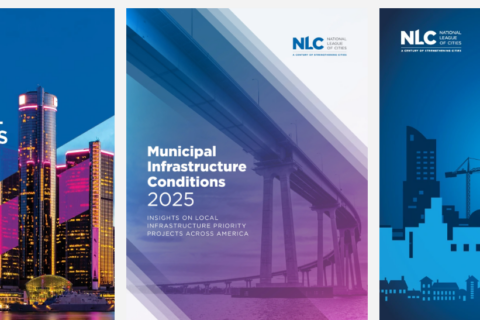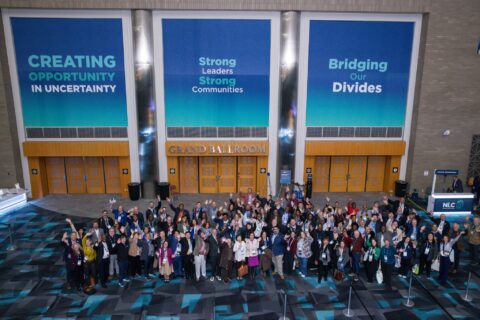Authored by the Edison Electric Institute (EEI)
Across the country, the energy system is straining under twin pressures: rapid demand growth (especially from large new users like data centers) and escalating risks from extreme weather and catastrophic events. A new report from the Critical Consumer Issues Forum (CCIF) distills a year of dialogue among state regulators, consumer advocates and electric companies into practical guidance for how to invest in the grid while keeping power reliable and affordable. For city leaders, the message is clear: local decisions on land use, permitting, resilience, and economic development are now inseparable from the health of your community’s power system.
Why Cities Should Care
Economic development is changing the load curve. Data centers, electrified transit and buildings and industrial reshoring can add massive “lumpy” loads to local systems, sometimes on compressed timelines. These opportunities can bring jobs and tax base, but they also require timely transmission upgrades, new generation and smarter distribution planning. If cities aren’t at the table early, they risk delays, higher costs or misaligned infrastructure that doesn’t serve broader community goals.
Extreme weather is redefining “reliability.” Heat waves, deep freezes, wildfires and hurricanes are more frequent and severe. CCIF emphasizes shifting from a culture of fast restoration to one of prevention and mitigation by hardening lines, modernizing protection systems, improving vegetation management and investing in distributed energy resources that keep critical loads operating.
Affordability and equity are on the line. Poorly structured growth can shift costs to households and small businesses. CCIF’s consensus is that costs to serve new, very large loads should not be shifted to other customer classes, and that revenues from these customers should, wherever possible, put downward pressure on everyone else’s rates. Cities have leverage to advocate for these consumer protections.
What the Report Means for Cities
1) Plan growth and power together. Align economic development timelines with utility planning cycles. Require early utility consultation and transparent load forecasts, including options for flexible operations (e.g., load shedding, on-site storage and participation in demand response).
2) Insist on “no cross-subsidy” rate design. Advocate at your state commission for tariffs and contracts that assign the cost of new generation, transmission upgrades and interconnection studies to the customers who drive them paired with clear guardrails (performance requirements, credit provisions and consequences for early exits). Cities can submit comments, join intervenor coalitions or coordinate with consumer advocates to keep residential and small business customers protected.
3) Treat resilience as essential infrastructure. Integrate grid-hardening priorities into local hazard mitigation, comprehensive plans and capital budgets. Map critical facilities (water, wastewater, shelters, public safety and cooling centers) and collaborate with electric companies on targeted undergrounding, sectionalizing, microgrids and backup power for those nodes. Seek diversified funding sources, including federal programs, to reduce the burden on ratepayers (a key CCIF theme).
4) Modernize permitting and community engagement. Transmission and substation projects often falter on siting. Cities can streamline permitting with clear design standards, predictable timelines and early, inclusive engagement, particularly with landowners and frontline communities. Transparent communication about why projects are needed and how they reduce outage risk is vital to public trust.
5) Use data to lower costs. CCIF calls for better planning and forecasting. Cities can contribute by sharing growth and electrification data (building permits, fleet conversion plans and heat pump adoption) to improve utility forecasting and avoid both overbuilding (stranded assets) and underbuilding (resource adequacy risks). Encourage time-of-use programs, managed charging for fleets and building load flexibility to smooth peaks.
6) Coordinate regionally. Extreme events don’t respect city limits. Work through MPOs, COGs and mutual-aid networks to align resilience standards, prioritize cross-jurisdictional corridors and speed restoration. Regional coordination can unlock more cost-effective projects and shared benefits.
A Practical City Action Checklist
- Convene a quarterly “Power & Growth” roundtable with your utility, major customers (including data centers), transit agency, school district, hospitals and emergency management to align timelines and share load and resilience plans.
- Adopt a Large Load Review Ordinance that requires early utility sign-off, a grid impact statement and a flexibility plan (on-site storage, demand response participation) for projects over a defined MW threshold.
- Prioritize resilience zones around critical facilities; pursue microgrids and storage using a mix of grants, bonds and utility programs.
- File or join comments at the state commission supporting cost-causation tariffs for new large loads and risk-spend efficiency metrics for resilience investments.
- Launch citywide demand flexibility: managed EV charging for municipal fleets, building performance standards with load-shifting options and incentive pathways for commercial backup assets to support the grid.
Bottom Line
Growth is good, but only if it’s grid-ready and equitable. Cities that proactively align land use, permitting, resilience and utility planning will capture new investment while protecting affordability and reliability for every resident. CCIF’s consensus principles offer a roadmap; local leadership can turn them into results.
Visit the NLC Strategic Partnerships page to learn more about the organizations like EEI dedicated to making NLC the premier resource for local governments.










